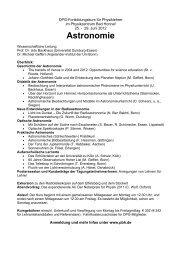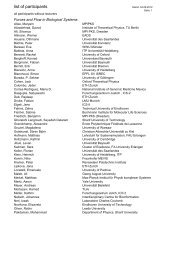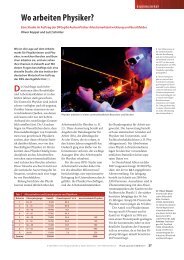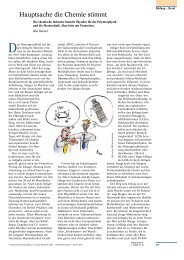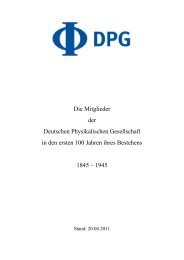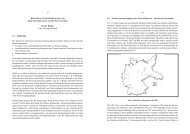Magnetism Division Fachverband Magnetismus (MA ... - DPG
Magnetism Division Fachverband Magnetismus (MA ... - DPG
Magnetism Division Fachverband Magnetismus (MA ... - DPG
Create successful ePaper yourself
Turn your PDF publications into a flip-book with our unique Google optimized e-Paper software.
<strong>Magnetism</strong> <strong>Division</strong> (<strong>MA</strong>) Overview<br />
A single femtosecond circularly polarized laser pulse can cause a well-controlled permanent magnetization<br />
reversal in materials typically used for data storage. Instant heat transfer makes a system<br />
susceptible to the magnetic moment inquired from the next coming circularly polarized pulse. Magnetization<br />
is controlled without any help of an external magnetic field. This, in turn, ensures magnetic<br />
stability of the neighboring domains as no stray fields affect them.<br />
Along with the benefits of downscaling some significant obstacles such as heat dissipation are encountered.<br />
However, this drawback that limits the recording density can be solved in future by<br />
magnetically activated local cooling of an individual nanometer-sized area. Pure spin currents resulting<br />
from a spin Seebeck effect are not accompanied by a net charge transfer and provide more<br />
deep insight into the spin-dependent phenomena (spin-orbit coupling, role of spin in energy transfer,<br />
spin-spin interactions). In addition, a spin-polarized current can be utilized for magnetization<br />
manipulation, a phenomenon called spin torque transfer. An angular momentum from the polarized<br />
current is transferred to the free layer magnetization and switches it at a certain current strength.<br />
In contrast to the other magnetization switching mechanisms, the spin torque transfer has the highest<br />
potential for increasing memory capacity, atomic accuracy in resolution (spin-polarized STM,<br />
for example) and a low heat generation. As an advanced solution it can be implemented in a new<br />
state-of-the-art memory generation.<br />
This symposium will provide an introduction into modern spintronics, covering their physical principles<br />
and the materials used for magnetic devices. After this introduction the magnetization dynamics<br />
and the mechanisms of magnetic switching will be discussed.<br />
<strong>MA</strong> 40.1 Thu 10:00–10:30 BH 243 Magnon Spintronics — ∙Burkard Hillebrands, Andrii Chumak,<br />
Alexandr Serga, Benjamin Jungfleisch<br />
<strong>MA</strong> 40.2 Thu 10:30–11:00 BH 243 Functional materials for spintronics, magnetic devices and magnetization<br />
dynamics — ∙Günter Reiss, Andreas Hütten, Jan Schmalhorst,<br />
Markus Meinert, Daniel Ebke, Andy Thomas, Hans-Werner<br />
Schumacher, Markus Münzenberg, Sergej Demokritov<br />
<strong>MA</strong> 40.3 Thu 11:00–11:15 BH 243 Revealing the significance of heating in the all-optical switching process<br />
— ∙Sabine Alebrand, Daniel Steil, Alexander Haßdenteufel,<br />
Mirko Cinchetti, Martin Aeschlimann<br />
<strong>MA</strong> 40.4 Thu 11:15–11:30 BH 243 Large relaxation times in permalloy reprogrammable magnonic crystals<br />
— ∙Rupert Huber, Thomas Schwarze, Georg Duerr, Dirk<br />
Grundler<br />
<strong>MA</strong> 40.5 Thu 11:30–12:00 BH 243 Spin wave propagation and excitation, microwave assisted switching<br />
and non-linear magnetic resonance — ∙Georg Woltersdorf, Hans G.<br />
Bauer, Christian H. Back<br />
<strong>MA</strong> 48.1 Thu 13:00–13:30 BH 243 Ultrafast manipulation of magnetic order — ∙Theo Rasing<br />
<strong>MA</strong> 48.2 Thu 13:30–14:00 BH 243 Spin-transfer processes: Magnetic coupling, spin-transfer torque,<br />
and pure spin currents — ∙Daniel E. Bürgler<br />
<strong>MA</strong> 48.3 Thu 14:00–14:15 BH 243 Improved reliability of magnetic field programmable gate arrays<br />
through the use of memristive tunnel junctions — ∙Jana Münchenberger,<br />
Patryk Krzysteczko, Günter Reiss, Andy Thomas<br />
<strong>MA</strong> 48.4 Thu 14:15–14:30 BH 243 Manipulation of Skyrmions created by opto-magnetic switching —<br />
∙Stefan Gerlach, Denise Hinzke, Ulrich Nowak<br />
<strong>MA</strong> 48.5 Thu 14:30–15:00 BH 243 Magnetoelastic Magnetization Control and Magnetization Dynamics<br />
at Low Temperatures — ∙Hans Huebl, Andreas Brandlmaier,<br />
Christoph Zollitsch, Johannes Lotze, Mathias Weiler, Fredrik<br />
Hocke, Georg Woltersdorf, Ruldof Gross, Sebastian T.B. Goennenwein<br />
Invited and Topical Talks of the Joint Session “Novel Spincaloritronic Devices: Control of Heat,<br />
Charge and Momentum Flow” (jointly with TT)<br />
Organization: Markus Münzenberg (Univ. Göttingen), Mathias Weiler (WMI Garching)<br />
<strong>MA</strong> 42.1 Thu 15:00–15:30 EB 301 Spin Seebeck and spin Peltier effects in ferromagnetic-nonmagnetic<br />
devices — ∙Bart van Wees<br />
<strong>MA</strong> 42.2 Thu 15:30–16:00 EB 301 Magneto Seebeck effect in tunnel junctions — ∙Christian Heiliger<br />
<strong>MA</strong> 42.3 Thu 16:00–16:30 EB 301 Seebeck spin tunneling into silicon — ∙Ron Jansen



